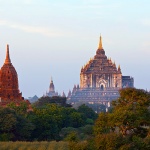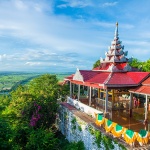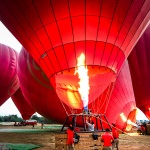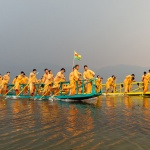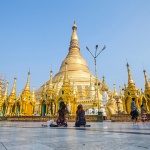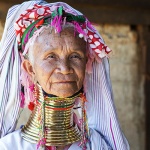by Uma Mageshwary Gunasakaran
Learning that the Bagan Archaeological Zone accommodates over 2,000 temples and pagodas, we knew that just one day wouldn’t be enough to explore this commendable ancient city. So, we spent one full day covering the famous ones highlighted in most articles, blogs and brochures, and the next day scouting around for the less popular ones.
Using Google Maps as our main guide and with the help of some pointers from blogs, we planned our route around Old Bagan, tagging about 6 temples and hoping to stumble upon a few more. We headed out on our quest just about an hour before the break of dawn.
First stop, a beautiful monument known for breathtaking views of the sunrise – the Law Ka Ou Shaung temple. We followed a dirt road on the west of Shwesandaw Pagoda and arrived at Law Ka Ou Shang. The morning twilight illuminated our way up the narrow stairway to the second and third floors of the pagoda.
There were about a dozen people already at the viewing platform at 5:30 AM, but the crowd was definitely smaller than the size typically found at the more popular temples. Here, we witnessed the glimmering rays of the sun across the Myinkaba plain, rising from behind the Shwesandaw Pagoda. At about 6:30 AM, the hot air balloons started to take off in the distance, creating an out-of-this-world sight.
Picture 1: Glimmering rays of the sun emerging from the horizon of the Myinkaba plain.
We got back onto the main road and headed to the Bulethi temple, also formerly famed for its sunrise and sunset views. However, since the earthquake in 2018, visitors are no longer permitted to climb up this temple to catch a view of the balloon-filled skies, as the structure is deemed unstable.
Nevertheless, the Bulethi temple was a monument worth visiting for its beautiful tiered architecture. From here, we sped to the northmost point of Old Bagan on our e-bikes, to the Nat Taung Kyaung Monastery. Erected in a secluded clearing enclosed by dense vegetation, this is the oldest wooden monastery in Bagan furnished by intricate wooden carvings.
Picture 2: The beautiful three-tiered Bulethi temple.
Picture 3: Nat Thaung Kyaung Monastery is the oldest wooden monastery in Bagan.
Less than 2 kilometres down south from the monastery lies Maha Bodhi Phaya just west of the Bagan Golden Palace. This temple is very similar to Bodh Gaya temple in India as its architecture is heavily influenced by the latter. Their similarity is contributed by Burmese architects who were sent to restore the Bodh Gaya temple in India in the 12th century following its devastation by the invading Turks. These architects later returned to Bagan and constructed the Maha Bodhi Phaya.
The temple consists of a pyramidal tower erected in the centre of a square base, and has around 450 Buddha statues embedded within numerous alcoves around the building. Its design definitely stood out, compared to all the monuments we had visited so far.
Picture 4: The architecture of the Maha Bodhi Phaya certainly stands out with its pyramidal tower.
By now, we had done a loop of the northern region of Old Bagan and arrived at another noteworthy pagoda, just within the vicinity of the first temple we visited this morning, which was the Mingalar Zedi Pagoda.
Though it may not appear in a list of top 10 monuments to visit in Bagan, this pagoda is immensely important in the history of the Bagan empire for it’s the last of the large monuments to be built in Bagan before Kublai Khan led the Mongol army to storm Bagan. Consequently, this marks the end of Bagan-style architectural development. Another notable feature of Mingalar Zedi is the set of glazed terracotta plaques, fixed along the terraces, detailing the 457 Jataka tales.
Picture 5: Mingalar Zedi, the last of the Bagan-style architectural feat.
We rode into New Bagan for a quick lunch at the Kyaw Kitchen, and then headed to the nearest pagoda just outside New Bagan – the Dhammayazika Pagoda. Its shiny gilded bell-shaped dome beckoned us from the main road and we were drawn to it like moths to light.
This temple is unique for its pentagonal base design that stands out from the typical square form of most temples, with entrances on all five sides. This motif is intended to include the Maitreya Buddha, the fifth form of Buddha who is predicted to appear in the future.
We walked past some vendors selling local products and up the brick stairway taking us up to an arched and beautifully decorated entrance gate. The gate led to a garden surrounding the pagoda, where we took a leisurely stroll, admiring this splendid pagoda.
Picture 6: The pentagonal Dhammayazika Pagoda, designed for the 5 forms of Buddha.
From the Dhammayazika Pagoda, we rode up north for about 2 kilometres along the dirt road, stopping by a few small temples along the way, namely the Tha Mu Hti Temple and Pagoda 761. We turned into the road leading to the colossal Dhammayangyi Temple that we visited the day before, went a little further past it and arrived at a quainter temple of Myauk Guni.
This temple was built by Queen Pwasaw in the 13th century and houses a white stone inscription by the queen describing the donation of the temple, land and the slaves who built it. We decided to catch the sunset here as it was less crowded than the other “sunset temples”. Besides, it is located in the centre of the Bagan Archaeological Zone. We climbed up a narrow stairway at the side of the temple to enjoy a stunning 360-degree view of the major monuments in Bagan as the sun sank into the horizon.
Picture 7: The quaint Myauk Guni Temple, perfect for an uncrowded sunset experience.
Pleased with all the interesting sites we had visited for the day, we took an unhurried ride back to our hotel. As it was past nightfall, we stuck to the tarred roads, instead of the dirt ones, and coursed past some temples and pagodas.
In the dark, the major monuments came alive as they were illuminated by electric lights, and the sight was simply glorious. Despite the long and tiring day, we were glad to have stayed out until night for this invaluable experience.

